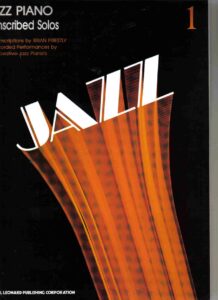Browse in the Library:
Or browse in the categories menus & download the Library Catalog PDF:
Sidney Bechet – Petite Fleur (piano solo ver. with sheet music)

Sidney Bechet
Sidney Bechet (New Orleans, Louisiana, United States, May 14, 1897 – Garches, May 14, 1959) was an American jazz musician and composer.
He was the seventh of the children of Josephine and Omar Bechet, who was a shoemaker and played the flute as a hobby, a child prodigy on that instrument. He was part of a family band called ‘The Silver Bells’ led by his brother Leonard Bechet.
Later, he was part of several New Orleans brass bands. In 1917, he moved to Chicago, where he played with Freddie Keppard and Joe ‘King’ Oliver among other musicians.
In 1919, he traveled to Europe with conductor Will Marion Cook’s Southern Syncopated Orchestra, where in addition to playing the clarinet, he performed a piece on a small accordion. The reception on the continent was so enthusiastic that he did not return until 1922, three years later. His presentations in London playing the Characteristic Blues caught the attention of the conductor Ernest Ansermet, who, in an article published in the specialized magazine Revue Romande, stated: ‘Sidney Bechet is a genius’. This is believed to have been the first journalistic criticism of a jazz musician.
Being in London, he became interested in the soprano saxophone, an instrument that he adopted and used more and more frequently than the clarinet, although he always carried a small accordion with him, with which he recorded only 2 pieces in 1924: ‘Wild Man Blues’ and ‘Indiana’. Returning to the United States in 1922, he settled in New York City, where he recorded his first record on July 30, 1923, with the Clarence Williams Blue Five on Wild Cat Blues and Kansas City Man Blues.
Between 1924 and 1925 he made a series of recordings with his colleague and compatriot, jazz trumpeter and vocalist Louis Armstrong, who had also joined Clarence Williams’ recording ensembles. Later, he joined the Revue Négre orchestra, which accompanied the dancer and singer Joséphine Baker to Paris in 1925, remaining in Europe until 1931, visiting various countries and spending 11 months in a French prison in 1928, for getting involved in a fight between musicians.
After that incident, he continued touring Europe and returned to the United States again, to participate briefly in the Noble Sissle orchestra, and then in 1932 he formed a group called The New Orleans Feetwarmers, together with the trumpeter Tommy Ladnier, with which they manage to perform only a recording session, but with 6 titles of notorious quality (including Maple Leaf Rag).
After that, and in the midst of the prevailing crisis in the United States, added to his low popularity, given his prolonged absence from the country, he finds it necessary to open a modest tailor shop in Harlem to survive.
Please, subscribe to our Library.
If you are already a subscriber, please, check our NEW SCORES’ page every month for new sheet music. THANK YOU!
Between 1934 and 1938 he again joined Noble Sissle, in whose orchestra he gradually acquired a growing participation as a soloist. From 1938 onwards, he embarked on a career as a leader of diverse groups, within the current of the New Orleans jazz revival, playing and recording in different cities and circumstances.
In 1939, he made a series of recordings for Alfred Lion’s recently created Blue Note record label, most notably an instrumental version of composer George Gershwin’s classic ‘Summertime’.
In 1941, he carried out an unprecedented experiment for the time: a session in which he played six instruments (clarinet, soprano saxophone, tenor saxophone, piano, double bass and drums), which were recorded one on top of the other, to form the Sidney Bechet’s one-man band, the first recorded attempt by a single musician and which became one of the references for the emergence of multitrack recording.
In 1949, he traveled to France to participate in the Paris Jazz Festival, at the Salle Pleyel. His interpretations captivate the French public and the following year he returns to Paris to settle there permanently, becoming a celebrity of the French traditional jazz movement, integrating the formations of the clarinettists Claude Luter and André Reweliotty.
In 1951, he married the German Elisabeth Ziegler (with whom he had had a relationship in Berlin in the late 1920s), in a ceremony that took place in the villa of Juan-Les-Pins. That year, he composes one of his biggest hits, Petite Fleur (Little Flower).
In 1954, his only son, Daniel, was born, and after almost 10 years of permanent residence in France, with tours and presentations throughout Europe, several gold records, and other successes, the musician was diagnosed with lung cancer towards the end of 1958, dying in Paris on May 14, 1959, the same day he was 62 years old. In the town of Juan-Les-Pins, there is a bust in memory of him, and in Paris there is a street with his name.
Browse in the Library:
Or browse in the categories menus & download the Library Catalog PDF:
